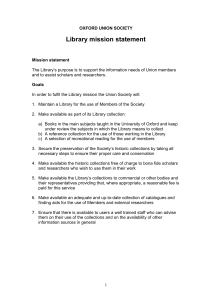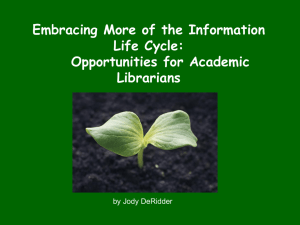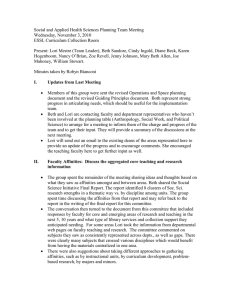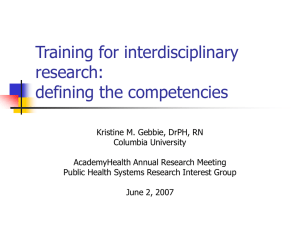Social Sciences and the UIUC Library in 2029 4-30-04
advertisement
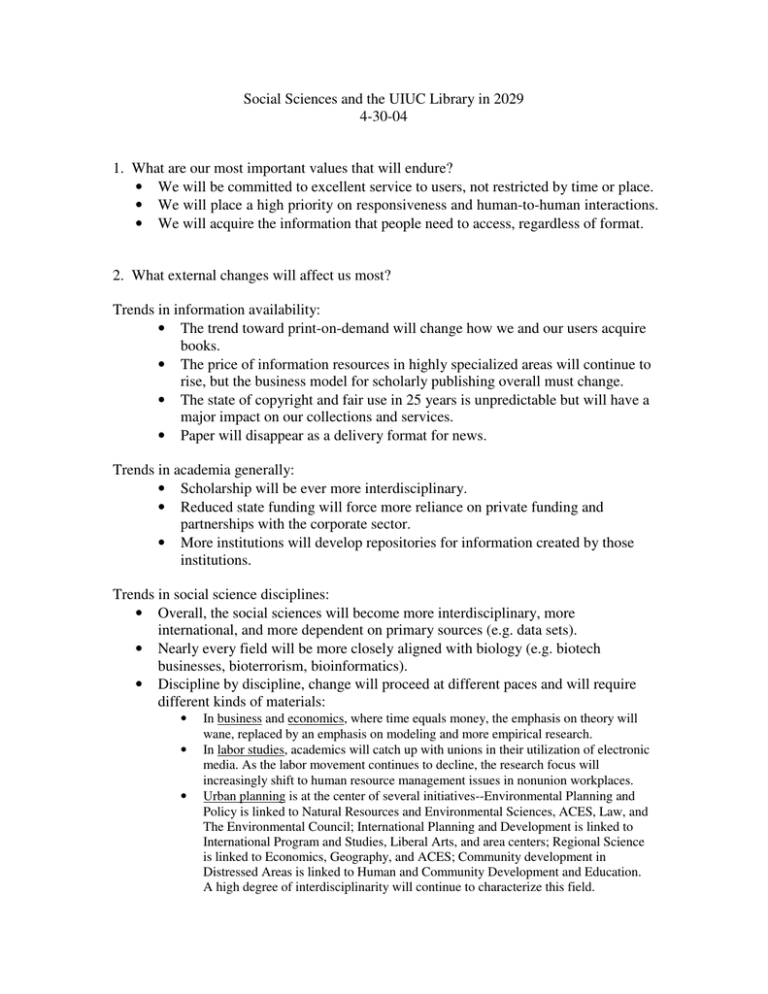
Social Sciences and the UIUC Library in 2029 4-30-04 1. What are our most important values that will endure? • We will be committed to excellent service to users, not restricted by time or place. • We will place a high priority on responsiveness and human-to-human interactions. • We will acquire the information that people need to access, regardless of format. 2. What external changes will affect us most? Trends in information availability: • The trend toward print-on-demand will change how we and our users acquire books. • The price of information resources in highly specialized areas will continue to rise, but the business model for scholarly publishing overall must change. • The state of copyright and fair use in 25 years is unpredictable but will have a major impact on our collections and services. • Paper will disappear as a delivery format for news. Trends in academia generally: • Scholarship will be ever more interdisciplinary. • Reduced state funding will force more reliance on private funding and partnerships with the corporate sector. • More institutions will develop repositories for information created by those institutions. Trends in social science disciplines: • Overall, the social sciences will become more interdisciplinary, more international, and more dependent on primary sources (e.g. data sets). • Nearly every field will be more closely aligned with biology (e.g. biotech businesses, bioterrorism, bioinformatics). • Discipline by discipline, change will proceed at different paces and will require different kinds of materials: • • • In business and economics, where time equals money, the emphasis on theory will wane, replaced by an emphasis on modeling and more empirical research. In labor studies, academics will catch up with unions in their utilization of electronic media. As the labor movement continues to decline, the research focus will increasingly shift to human resource management issues in nonunion workplaces. Urban planning is at the center of several initiatives--Environmental Planning and Policy is linked to Natural Resources and Environmental Sciences, ACES, Law, and The Environmental Council; International Planning and Development is linked to International Program and Studies, Liberal Arts, and area centers; Regional Science is linked to Economics, Geography, and ACES; Community development in Distressed Areas is linked to Human and Community Development and Education. A high degree of interdisciplinarity will continue to characterize this field. • • • • • • • In landscape architecture, scholars will continue to need high-quality illustrations. In library and information science, either the discipline will cohere with a more unified core knowledge than it now has, or it will finally split apart into separate disciplines of library science and information science. Both research and practice will be transformed by accelerating innovations in technologies (especially mobile technologies) for information creation and retrieval. Information content will be almost exclusively digital. In both anthropology and sociology, the emphasis on in-depth, longitudinal studies means that the monograph will continue to be the primary vehicle of scholarly communication, but access to data archives and concomitant data services will become increasingly important. The demand for geospatial data, in particular, will grow. Research on the interplay between the global and the local will continue to fuel interdisciplinary scholarship with an area studies focus. In education, both print and electronic resources will be needed, with emphasis on electronic access for off-site educators and students. Print, kits, and multi-media materials will be used in teacher education programs where physical items in the preK-12 classroom will still be part of the learning experience. Communications technology, research and practice have seen an expansive growth throughout the 20th century and never more than in the past ten years. The future importance of communication can only increase as it ties together so many interdependent fields (sciences, humanities and social sciences). Scholars from these areas will rely on theoretical as well as “practical” sources, print as well as electronic and even more, non-print or audiovisual resources. Research in the psychological sciences indicates continued primary growth in the areas of affective, cognitive and neurosciences. Studies in social work will increasingly emphasize mental health, issues of diversity and together with scholars and professional personnel in psychology generate increased studies that connect and explain the physiological mechanisms tied to physical health, emotional well-being and language development—largely due to a rapidly changing, racially and linguistically diverse population. It is anticipated that the steady rise in interdisciplinary research will continue to drive the increased demand for electronically available and current journals and ephemera. Those more traditional areas of these disciplines will continue to rely upon literature retrieved from a mixture of formats as is reflected in the scholarship. The discipline of political science will continue to require all types of materials books, journal articles, and datasets in the future. A dichotomy of methodologies is currently evolving in this subject area, and it is too early at this point to tell whether the rational choice, game theory camp will overwhelm the more traditional schools of thought. What we can be sure of for the next twenty-five years is the continuing blurring of borders between this discipline and others such as economics, sociology, military science, labor, agriculture, and genetics due to the reality of a world in the throes of globalization. 3. How will our users behave? What will they need? • Users in some applied fields (e.g. student teachers, social workers) will still need paper materials. • Users in other fields (e.g. business, LIS) will be fully immersed in the electronic information world. • Users will expect immediate delivery of information when and where needed, through various technologies including desktop and laptop computers, largescreen displays, and cell phones or other small appliances. • • • Each successive generation will be more and more media-literate. In 25 years, the normal methods of seeking information, and the ways of thinking about that information, will differ dramatically from how people raised on print seek information and view the world. But media literacy will not necessarily include critical thinking skills for evaluating information. Librarians will still need to model and instill these skills in information users. Technological advances will make virtual reference “seamless” and available 24/7. 4. What will our collections be like? • Our collections will be largely electronic, but the print/electronic ratio will vary dramatically among disciplines. • Information will break free from print formats (books versus journals versus reference tools). Integrated information resources like CQ Voting & Elections and CogNet are early signs of what’s to come. 5. What will our facilities be like? • New library buildings – for example, a special collections building -- will free up much-needed space in the Main Library and provide us with more flexibility to consolidate services and collections. • The children’s literature collection will be in one place, accessible and browsable by users. • To fund building upgrades, the Main Library will offer space to ‘tenants’ whose missions, clientele, or work processes complement ours. • There will be fewer departmental libraries due to consolidations, but discipline-based subject expertise will continue to be needed and valued. 6. What will our workforce be like? • Retirement of the “boomers” will result in significant turnover, bringing fresh knowledge and ideas but also losing much institutional memory. • Overall the Library workforce will be smaller. • The workforce will be more diverse in terms of skills and qualifications, and tenure-track librarians will constitute a smaller portion of the Library workforce. • The new generation of workers will be accustomed to team work and will prefer it. • Unless the Library is willing to deal with a much more transient workforce, it will establish more exciting career paths to attract and retain support staff. • The Library will continue to support professional development in the library profession by providing graduate assistant opportunities to students in allied areas. • While many elements of library philosophy and practice will endure, librarians’ knowledge sets must expand to place greater emphasis on: o Criteria and methods for assessing the quality of information. o Design of usable interfaces to information, especially for remote users. o Deeper understandings of learning styles and information-seeking styles. o A level of comfort using visual media, such as live video, to communicate with users, equal to today’s comfort with face-to-face or text chat communication.

